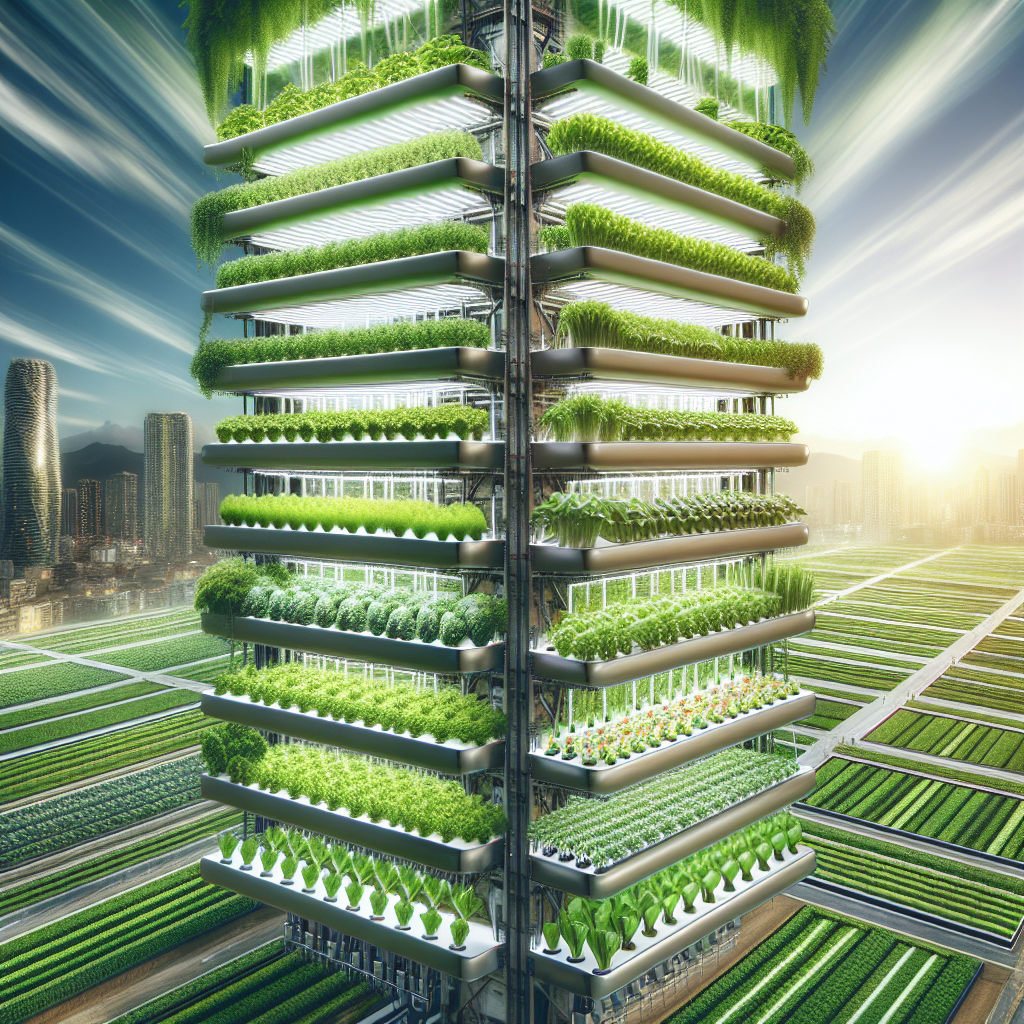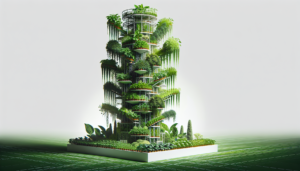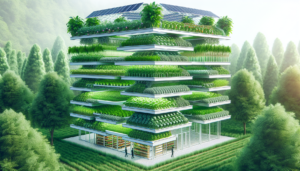
Imagine a world where food is grown not in sprawling fields, but in towering structures filled with rows upon rows of crops. This is the vision of the future of agriculture, where vertical farming equipment takes center stage. In these innovative vertical farms, the limitations of traditional agriculture are shattered as crops are stacked vertically, maximizing space and efficiency. From automated irrigation systems to LED lighting tailored to each plant’s needs, this cutting-edge equipment promises to revolutionize the way we grow food. Join us as we explore the possibilities and potential of this game-changing technology.
Introduction
Vertical farming, a revolutionary agricultural method, is gaining traction in the modern era. With the use of innovative technology, this farming technique allows crops to be grown in vertically stacked layers, making the most efficient use of limited space. This article will explore the benefits of vertical farming, the challenges it faces, and the various equipment that makes this agricultural practice possible.
Benefits of Vertical Farming
Increased Crop Yield
One of the primary advantages of vertical farming is its potential to significantly increase crop yield compared to traditional farming methods. By utilizing vertical space, farmers can grow multiple layers of crops, maximizing the production capacity per square foot. This increased yield not only helps meet the growing demand for food production but also allows for a more sustainable use of land resources.
Year-Round Production
Vertical farming presents the opportunity for year-round crop production, regardless of external factors such as weather conditions or seasonal changes. By providing a controlled indoor environment, farmers can manipulate growing conditions, ensuring optimum temperature, humidity, and light levels for the plants. This consistency in production can help stabilize food supply, reduce dependence on imports, and mitigate the effects of climate change on agriculture.
Conservation of Resources
Traditional agricultural practices often require vast amounts of resources, including land, water, and fertilizers. Vertical farming, however, offers a more resource-efficient alternative. By utilizing hydroponics or aeroponics, where plants are grown in nutrient-rich water or mist rather than soil, vertical farms can reduce water consumption significantly. Additionally, as the environment is controlled, there is minimal loss of nutrients, avoiding over-fertilization and minimizing waste.
Reduced Dependence on Weather Conditions
One of the major challenges faced by traditional farmers is their reliance on favorable weather conditions for successful crop growth. Extreme weather events, such as droughts or floods, can devastate entire harvests. Vertical farming eliminates this vulnerability by providing a controlled environment where climate conditions can be adjusted to optimize plant growth. This helps ensure consistent and reliable crop production, regardless of external weather conditions.
Challenges in Vertical Farming
High Initial Investment
One of the primary challenges in adopting vertical farming is the high initial investment required to set up a vertical farm. The cost of acquiring specialized equipment, such as grow lights and climate control systems, can be substantial. Additionally, the construction and retrofitting of buildings to accommodate vertical farming infrastructure can further increase the investment cost. However, with advancements in technology and increasing demand for sustainable farming practices, the costs are gradually decreasing, making vertical farming more accessible to farmers.
Energy Consumption
The controlled environment of vertical farms necessitates the use of artificial lighting, HVAC systems, and other energy-intensive equipment. This increased energy consumption can pose challenges in terms of sustainability and operational costs. However, developments in energy-efficient technologies, such as LED grow lights, have significantly reduced energy consumption. Furthermore, the integration of renewable energy sources, such as solar panels, can help mitigate the environmental impact associated with high energy consumption.
Technological Advancements
While vertical farming relies heavily on technology, further advancements are still necessary to optimize the efficiency and productivity of these systems. Research is ongoing to develop improved crop monitoring and data analytics tools to track plant growth, nutrient levels, and environmental conditions. Additionally, advancements in automation and robotics can help streamline operations and reduce labor-intensive tasks. Continued technological advancements will play a crucial role in enhancing the scalability and profitability of vertical farming.
Vertical Farming Equipment
Grow Lights
Grow lights are an essential component of vertical farming as they mimic natural sunlight, providing the necessary light spectrum for photosynthesis. LED (Light Emitting Diode) grow lights have gained popularity in recent years due to their energy efficiency and customization options. LED grow lights emit light in specific wavelengths that cater to different stages of plant growth, maximizing photosynthetic efficiency.
Hydroponic Systems
Hydroponics is a soil-less cultivation technique that uses a nutrient-rich water solution to grow plants. Several types of hydroponic systems are commonly used in vertical farming:
Nutrient Film Technique (NFT)
In NFT systems, plants are placed in troughs or channels where a thin film of nutrient-rich water continuously flows past the roots. This technique ensures a constant supply of nutrients while allowing for the oxygenation of the root system.
Deep Water Culture (DWC)
DWC systems involve suspending plant roots in a nutrient-rich water solution. The roots are provided with oxygen through the use of air stones or diffusers. This method is known for its simplicity and effectiveness in supporting plant growth.
Wicking Systems
Wicking systems utilize a wick or capillary action to transport water and nutrients directly to the plant roots. This method is considered low-tech and requires minimal maintenance. It is particularly suitable for smaller plants or herbs.
Ebb and Flow Systems
Ebb and flow systems, also known as flood and drain systems, periodically flood the growing trays with nutrient-rich water solution and then drain it away. This cycling ensures that the plants receive the necessary nutrients while preventing water stagnation and root rot.
Aeroponic Systems
Aeroponics is another soil-less cultivation technique where plants are grown in an air or mist environment. In aeroponic systems, plant roots are suspended in a chamber where a fine mist of nutrient-rich water is periodically sprayed onto the roots. This method allows for increased oxygen exposure, promoting rapid and efficient nutrient absorption.
Vertical Farming Towers
Vertical farming towers, also known as tower gardens, utilize vertical space to grow crops in multiple layers. These towers are equipped with a hydroponic or aeroponic system and provide an efficient solution for maximizing crop yield within a limited footprint. Vertical farming towers are particularly suited for leafy greens and herbs.
Automated Watering and Nutrient Delivery Systems
To streamline operations and minimize labor, vertical farms often employ automated watering and nutrient delivery systems. These systems ensure precise and consistent delivery of water and nutrients to the plants, eliminating the need for manual intervention. This automation allows farmers to monitor and adjust the input parameters remotely, optimizing plant growth while conserving resources.
Climate Control Systems
To provide an ideal growing environment, vertical farms rely on climate control systems. These systems regulate temperature, humidity, and air circulation to create optimal conditions for plant growth. By maintaining stable climatic conditions year-round, farmers can ensure that crops receive the ideal environment for growth, enhancing productivity and yield.
Plant Monitoring and Data Analytics
Data-driven farming is becoming increasingly prevalent in vertical farming. Plant monitoring systems capture real-time data on plant health, growth rates, and nutrient levels. This information is then analyzed using advanced analytics software, providing valuable insights into the plants’ needs and optimizing resource allocation. By using data to make informed decisions, vertical farmers can maximize crop production and minimize resource wastage.
Robotic Systems
Automation through robotic systems is gradually revolutionizing vertical farming operations. Robots can perform a range of tasks, including seeding, harvesting, and maintenance, with precision and efficiency. These systems reduce labor requirements, increase productivity, and allow for consistent operation without human intervention. As technology continues to evolve, robotic systems will likely become an integral part of the vertical farming landscape.
Vertical Transportation Systems
Vertical transportation systems are designed to move plants efficiently between different levels of a vertical farm. These systems eliminate the need for manual labor, making the process more time-efficient and reducing potential product damage. By automating the transportation process, vertical farms can streamline their operations, ensuring an uninterrupted flow of produce.
Smart Farming Software
Smart farming software incorporates various technologies such as data analytics, Internet of Things (IoT), and artificial intelligence (AI) to optimize and automate farming operations. This software can monitor and control environmental conditions, nutrient delivery, and system performance. By leveraging real-time data and predictive analytics, smart farming software enables vertical farmers to make data-driven decisions that enhance productivity, reduce costs, and improve overall crop quality.
Grow Lights
LED Grow Lights
LED grow lights revolutionized vertical farming by providing energy-efficient and customizable lighting options. These lights emit light in specific wavelengths that cater to different stages of plant growth, optimizing photosynthesis and overall plant health. LED grow lights have surpassed traditional lighting systems, such as high-pressure sodium (HPS) and fluorescent lights, in terms of energy efficiency, longevity, and spectrum control.
Types of LED Grow Lights
There are various types of LED grow lights available, each with its unique characteristics and benefits.
-
Full Spectrum LED Grow Lights: These lights provide a balanced spectrum of light that mimics natural sunlight, promoting healthy plant development from seedling to harvest.
-
Red and Blue LED Grow Lights: These lights emit light in specific wavelengths within the red and blue spectrum, which are critical for photosynthesis and flowering stages. They are often used in combination to optimize plant growth and yield.
-
Supplemental LED Grow Lights: Supplemental LED lights are used in addition to natural or primary LED light sources to provide a boost in specific spectrums. These lights can be customized to specific crop requirements and growth stages.
Benefits of LED Grow Lights
LED grow lights offer numerous advantages over traditional lighting systems:
-
Energy Efficiency: LED grow lights consume significantly less energy compared to HPS and fluorescent lights, leading to energy cost savings and reduced carbon footprint.
-
Longevity: LED grow lights have a longer lifespan, lasting up to 50,000 hours or more. This reduces the frequency of bulb replacements and maintenance costs.
-
Customization: LED grow lights allow for precise spectrum control, enabling farmers to tailor the light output according to specific crop needs. This customization optimizes plant growth and maximizes crop yield.
-
Heat Management: LED grow lights emit less heat compared to traditional lights, reducing the risk of heat damage to plants and eliminating the need for additional cooling systems.
-
Compact Design: LED grow lights are compact and lightweight, making them easy to install in vertical farming systems. This flexibility allows for efficient use of vertical space and enables greater crop density.
Hydroponic Systems
Nutrient Film Technique (NFT)
Nutrient Film Technique (NFT) is a popular hydroponic system used in vertical farming. In NFT systems, a thin film of nutrient-rich water flows continuously over the roots of the plants. The roots absorb the necessary nutrients directly from the flowing solution while being exposed to oxygen. This technique ensures a consistent supply of nutrients while preventing waterlogging of the roots.
Deep Water Culture (DWC)
Deep Water Culture (DWC) is another hydroponic system commonly used in vertical farming. In DWC systems, plant roots are suspended in a nutrient-rich water solution, allowing them to absorb nutrients directly. Oxygen is supplied to the roots through air stones or diffusers, ensuring proper aeration. DWC is known for its simplicity and effectiveness in promoting rapid plant growth.
Wicking Systems
Wicking systems are simple and low-tech hydroponic systems suitable for smaller plants or herbs. In this system, a wick is used to transport the water and nutrients to the plants’ root zone. The wick draws the solution from a reservoir through capillary action, ensuring a constant supply of water and nutrients. Wicking systems require minimal maintenance and are a cost-effective option for small-scale vertical farms.
Ebb and Flow Systems
Ebb and Flow systems, also known as flood and drain systems, are commonly used in hydroponic vertical farms. These systems periodically flood the growing trays with nutrient-rich water solution and then drain it away. This cyclic process ensures that the plants receive the necessary nutrients while preventing water stagnation and root rot. Ebb and Flow systems are efficient and versatile, accommodating a wide range of crops.
Aeroponics
Aeroponics is a soil-less cultivation technique that relies on suspending plant roots in an air or mist environment. In aeroponic systems, nutrient-rich water is sprayed as a fine mist onto the roots, providing a direct and efficient means of nutrient delivery. The roots are exposed to oxygen, promoting rapid growth and nutrient absorption. Aeroponics allows for maximum use of vertical space and offers superior water efficiency compared to other hydroponic systems.
Aeroponic Systems
How Aeroponic Systems Work
Aeroponic systems are a high-tech hydroponic variant that suspends plant roots in an air or mist environment. In this system, plant roots are misted with a nutrient-rich water solution at regular intervals. The nutrient solution is delivered through high-pressure mist nozzles, ensuring that the roots receive a fine, oxygenated mist. This interaction of nutrients and oxygen enhances nutrient uptake and promotes rapid and healthy plant growth.
Advantages of Aeroponic Systems
Aeroponic systems offer several advantages over other growing techniques:
-
Increased Oxygenation: Aeroponics provides a high oxygen environment for the roots, promoting rapid nutrient absorption and overall plant health.
-
Water Efficiency: Aeroponics is one of the most water-efficient hydroponic systems, as it requires significantly less water compared to traditional soil-based farming.
-
Precise Nutrient Delivery: The nutrient-rich mist used in aeroponic systems ensures precise and targeted nutrient delivery directly to the roots, promoting efficient nutrient uptake and minimizing waste.
-
Optimized Crop Density: Aeroponic systems allow for maximum use of vertical space, enabling higher crop density and increased overall yield.
Challenges and Limitations of Aeroponic Systems
Aeroponic systems, while promising, also face several challenges and limitations:
-
Technical Complexity: Aeroponic systems require precise control of factors such as mist timing, nutrient concentration, and root exposure, which can be complex to maintain.
-
Risk of System Malfunction: Any disruption or failure in the misting system can have catastrophic consequences for plant health. Adequate backup systems and regular maintenance are crucial in mitigating this risk.
-
Sensitive to Environmental Changes: Aeroponic systems are sensitive to changes in environmental conditions, such as temperature and humidity. Maintaining optimal conditions consistently can be challenging, especially in regions with extreme weather conditions.
Vertical Farming Towers
Tower Garden Systems
Vertical farming towers, also known as tower garden systems, allow for the cultivation of plants in vertical stacks. These towers are designed to maximize space utilization and increase the overall yield per square foot. Tower garden systems typically utilize hydroponic or aeroponic techniques to grow crops in multiple layers. This vertical arrangement enables efficient use of both natural and artificial lighting and can be easily integrated into urban environments.
Benefits of Vertical Farming Towers
Vertical farming towers offer several advantages for sustainable agriculture:
-
Space Efficiency: Vertical farming towers utilize vertical space, making them suitable for urban farming where land availability is limited. By stacking plant layers, these systems can accommodate a greater number of plants within a smaller area.
-
Increased Crop Yield: The vertical arrangement of plants enables a higher crop density, resulting in increased overall yield. This increased productivity can help meet the growing demand for food in densely populated areas.
-
Reduced Environmental Footprint: Vertical farming towers minimize the need for land use, conserve water through efficient hydroponic or aeroponic systems, and reduce the use of synthetic fertilizers. This eco-friendly approach reduces the overall environmental impact associated with traditional farming methods.
-
Year-Round Production: Vertical farming towers provide a controlled indoor environment that allows for year-round production, regardless of external weather conditions. This consistent production helps stabilize food supply and reduce dependence on seasonal farming.
Automated Watering and Nutrient Delivery Systems
Watering Systems
Automated watering systems play a crucial role in vertical farming by providing a consistent and precise supply of water to the plants. These systems can be designed to deliver water at specific intervals or in response to moisture sensors. By automating the watering process, vertical farms can minimize water waste, maintain optimal moisture levels, and reduce labor requirements.
Nutrient Delivery Systems
To ensure the plants receive the necessary nutrients, automated nutrient delivery systems are often employed in vertical farms. These systems precisely mix and deliver the required nutrients to the plants, maintaining optimal nutrient levels for healthy growth. By automating nutrient delivery, vertical farms can avoid over-fertilization and ensure resource efficiency while promoting plant health.
Benefits of Automation
Automation in watering and nutrient delivery systems offers several benefits:
-
Precision and Consistency: Automated systems eliminate human error and provide precise control over the amount and timing of water and nutrients delivered to the plants. This precision ensures consistency throughout the growth cycle and reduces the risk of under or over-watering.
-
Resource Efficiency: Automated systems optimize resource usage by delivering water and nutrients in a targeted manner. This efficient utilization reduces waste and conserves resources, making vertical farming more sustainable.
-
Labor Savings: By automating watering and nutrient delivery, manpower requirements are significantly reduced. This frees up labor for other tasks and reduces operational costs.
Conclusion
Vertical farming equipment has revolutionized the agricultural industry, offering numerous benefits and solutions to address the challenges faced by traditional farming methods. The increased crop yield, year-round production, conservation of resources, and reduced dependence on weather conditions are just a few advantages of vertical farming. Despite the challenges of initial investment, energy consumption, and technological advancements, the future of agriculture lies in vertical farming. With innovations in grow lights, hydroponic and aeroponic systems, vertical farming towers, automated watering systems, and smart farming software, the potential of vertical farming to meet the increasing global demand for food is substantial. By embracing these advancements, farmers can maximize productivity, conserve resources, and contribute to a more sustainable and food-secure future.







